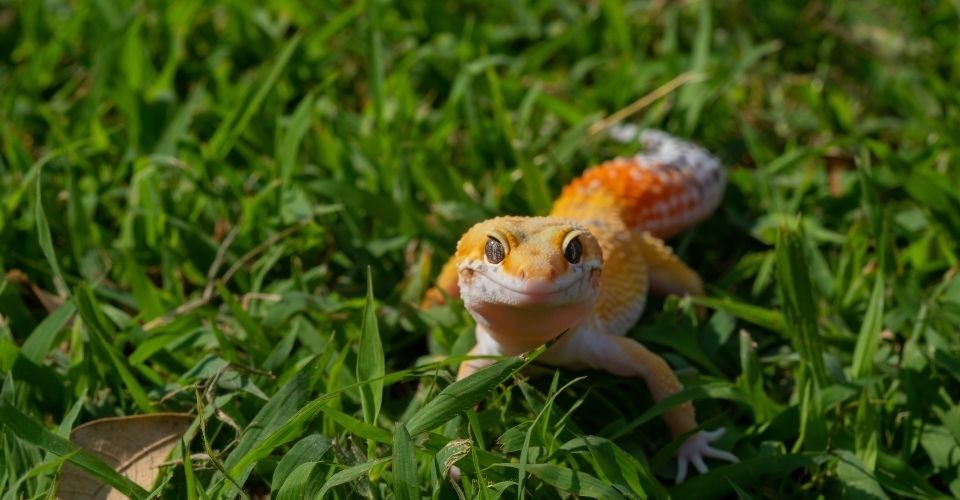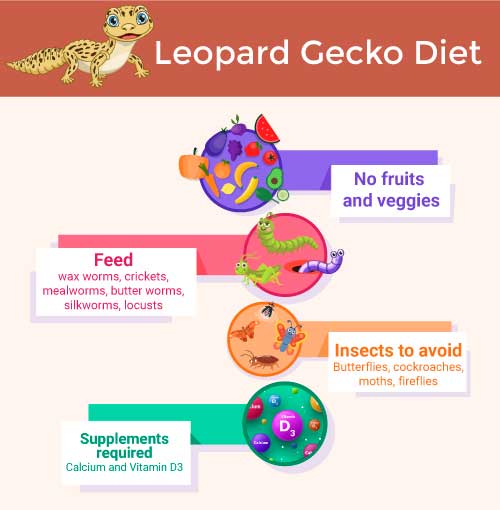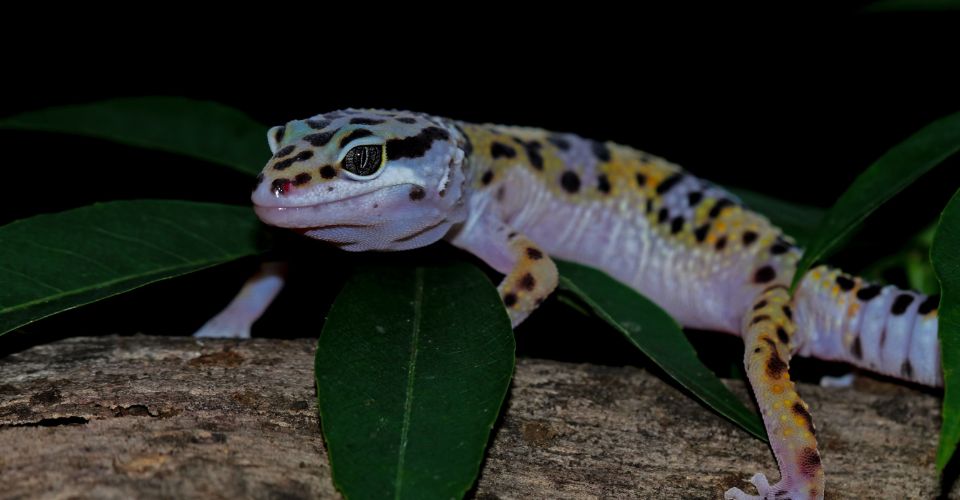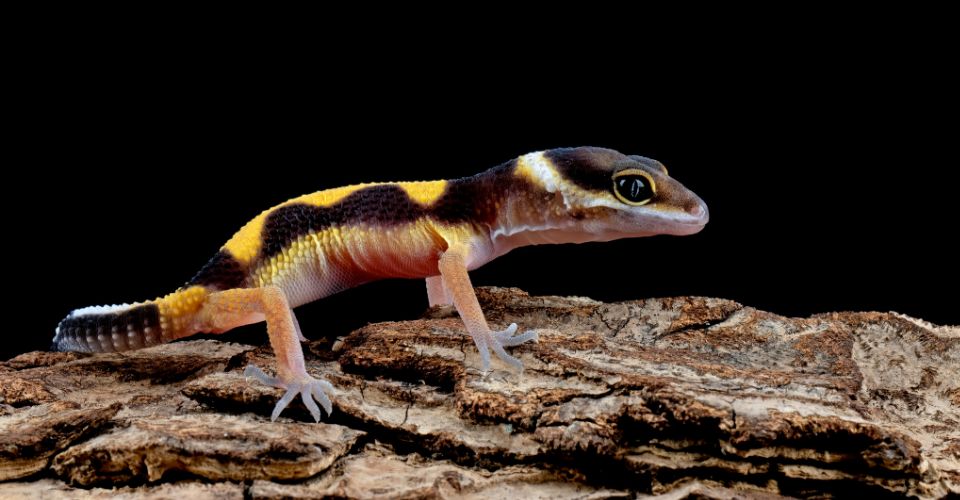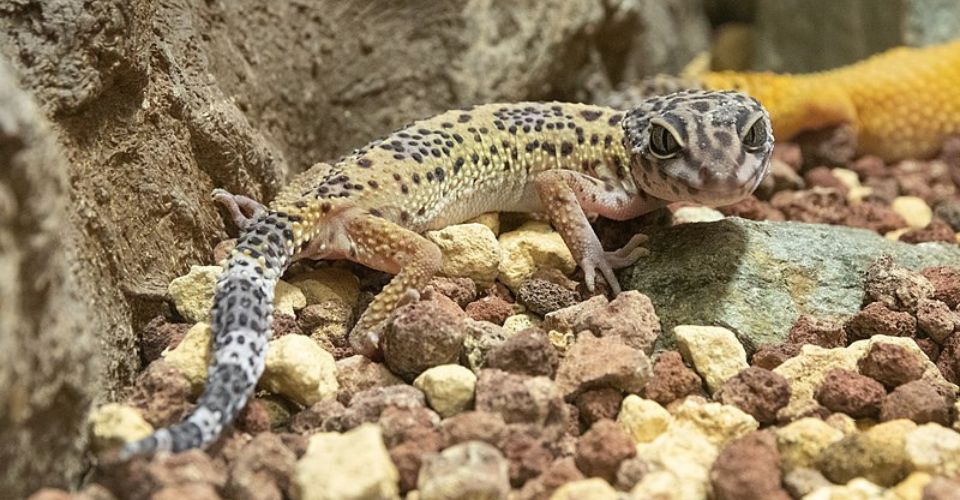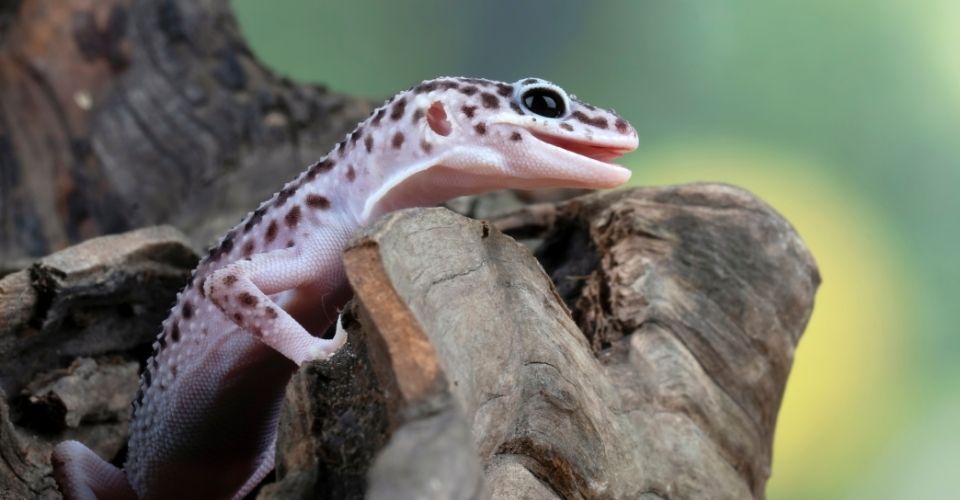Leopard geckos are popular insectivorous lizards found in Pakistan, Afghanistan, Iran, and India. These are small, adorable reptiles having spotted colors and sometimes referred to as the easiest reptiles that you can keep as pets.
The friendly nature of Leopard geckos makes them a popular pet for reptile keepers.
If you are trying to find out what to feed your Leopard gecko and how much is good for it, you are in the right place. First-time reptile keepers need to understand what feeding schedule is suitable for Leopard geckos, and that is precisely what we will talk about.
Leopard geckos are insectivores, meaning that they primarily feed on insects—invertebrates. But they are also opportunistic carnivores— if they are starving, they will eat prey such as small rodents, spiders, scorpions, and even other lizards.
The diet of geckos should consist of gut-loaded insects. It will keep your Leopard geckos healthy as it contains the necessary minerals and vitamins.
In this article, we will guide you in detail regarding the feeding pattern of Leopard geckos.
Leopard Gecko Diet
Leopard geckos rely on different insects and small animals to meet their dietary needs. The best insects suitable for Leopard geckos are crickets, waxworms, mealworms, locusts (small), etc. Leopard geckos’ diet may also include other worms such as silkworms, tomato hornworms, beetles, cockroaches, sowbugs, etc.
Leopard geckos are fond of butter worms. Butterworms are full of fats and contain calcium. Sometimes Leopard geckos get addicted to butter worms to such an extent that they may refuse all other food except butter worms.
Waxworms and super worms are also good sources of fats for your Leopard geckos. However, be very careful as an excess quantity of these worms can cause obesity in Leopard geckos. So, it is enough to give them waxworms and super worms once a week.
Be careful while feeding your Leopard geckos. Don’t offer them dead or dried insects. Also, avoid giving any vegetables or fruits to your Leopard geckos as they cannot eat fruit.
Lastly, note that Leopard geckos only eat live prey, which means they won’t eat anything dead. The reason is that they don’t get attracted to food for which they don’t have to put up a fight. Leopard gecko keepers should always offer live insects because canned or dead insects don’t stimulate the hunting modeof geckos.
It is better not to rely on just 1 to 2 kinds of insects. Leopard geckos should be offered a variety of food because it prevents nutrient deficiency.
How Much Does a Leopard Gecko Eat?
Whether a Leopard gecko is a baby, young, or an adult one, provide it with two insects for every inch of its body size. Baby and juvenile Leopard geckos need to eat every day. In comparison, adult Leopard geckos should only be given food every other day (not daily). Feed Leopard geckos with mealworms of standard size in small dishes.
Adult Leopard geckos should be offered 6 to 7 mealworms or crickets two to three times a week. While using supplements like Calci worms or waxworms, 3 – 5 worms three times a week is enough for geckos. The inclusion of Calci worms in the food is good for geckos as it adds the required amount of calcium to the diet.
Similarly, the need for fats can be fulfilled by including waxworms in the diet. Waxworms are also one of the favorite foods of Leopard geckos. They may get spoiled by eating it regularly and may refuse any diet other than this. So, be careful and use waxworms occasionally as a treat for your Leopard geckos. Lastly, always provide a dish of water to your Leopard geckos.
Do Leopard Geckos Eat Fruits and Vegetables?
Leopard geckos cannot eat fruits or vegetables because they are insectivores. Insectivores can only take in meat like insects. It is unusual for an insectivore (which relies on catching and eating insects) to eat fruits or vegetables. Even if they can eat it, this is not good for them.
The reasons why Leopard geckos can’t eat fruits or vegetables are discussed below:
- The digestive tract system of Leopard geckos is alkaline and shorter. Herbivores have an acidic and longer digestive tract; that’s why they can easily digest fruits and vegetables. The bodies of Leopard geckos are not capable of digesting fruits or vegetables.
- Fruits and vegetables contain varying amounts of cellulose. Cecum stores food where bacteria break down the cellulose component of food. Leopard geckos don’t possess a functioning cecum, which is why they are not capable of digesting fruits or vegetables.
- Another reason why fruits and vegetables are not suitable for these reptiles is that their skull and jaw have evolved with time to eat only meat.
However, some people have also reported that geckos can eat fruits. But we don’t recommend you to feed them this food as their bodies are not designed to digest fruits.
Therefore, naturally digestible food is recommended for Leopard geckos’ keepers. Sticking to the diet of insects is more suitable for your Leopard gecko than any other kind of food.
Baby Leopard Gecko Feeding Schedule
The metabolism rate of baby Leopard geckos is very high because they are during their development stages of life. This rapid growth during the development stage makes geckos ravenous eaters. Baby Leopard geckos need to eat more than adult ones. Usually, it is preferred to feed baby Leopard geckos once a day, while adults are fed food every other day, as stated above.
The daily diet for baby Leopard geckos should contain at least 5 to 7 mealworms or crickets. You should continue this diet until your baby Leopard geckos reach 4 inches in length. You can also offer them larger food items every other day until they are fully grown, i.e., after 10 to 12 months.
The preferable mode for feeding baby geckos is to use a small dish because they are more fearful than adult geckos and will not take food from their hands or tongs. The prey can move around in the dish, which attracts the Leopard geckos to capture them.
For the rapid growth of baby Leopard geckos, it is essential to give them as much food as they can eat in ten minutes. Remove the leftover food after 10 minutes.
You may notice that baby Leopard geckos may lose their desire to eat food during shedding. This attitude is usually temporary. However, if this behavior continues for more than four days, there may be something wrong with your gecko. In that case, it is better to consult a vet.
You can offer mealworms, roaches, and crickets to 4 inches Leopard gecko babies. Once a Leopard gecko reaches 10 months of age, you can introduce it to medium-sized food. The 12 months old Leopard geckos are grown up, and it is the right time to switch towards an adult feeding schedule.
Adult Leopard Gecko Feeding Schedule
The eating patterns of adult Leopard geckos are different than babies and juveniles. Adult geckos are fully grown and can store extra fats in their tails. So, these lizards have an excess energy supply if they want it. It is due to this energy supply that Leopard geckos can go without food for around 10 – 14 days without food.
We recommended feeding adult Leopard geckos on alternate days. The best time to feed a Leopard gecko is evening because they are nocturnal and remain more active during those times. Adult Leopard geckos can be fed with 6 – 7 mealworms or crickets every other day.
It is easy to feed adult Leopard geckos as they can be fed food items with either tong, hand, or dishes, unlike babies who only prefer eating from a dish. Leopard gecko owners should make sure to offer the right-sized prey to their pets.
Adult geckos are not much interested in food when they are shedding. However, it is advised to consult a vet if your pet doesn’t eat for more than two weeks. A Leopard gecko may lose interest in eating with a similar diet schedule. You must feed different types of insects to your Leopard geckos because they attract your pets and provide them a balanced diet.
Vitamins and Supplements
The diet of Leopard geckos should contain the required amounts of vitamins and supplements. For instance, calcium facilitates shedding in Leopard geckos. It is also necessary for the health of muscles and bones in these reptiles.
Similarly, vitamin D3 is essential for geckos as it helps to absorb and utilize calcium. Wild Leopard geckos fulfill their calcium and vitamin D3 needs naturally. Pet geckos can be fed these vitamins in the form of supplements. A diet lacking calcium and vitamin D3 may cause fatal illness, metabolic bone diseases, and malnutrition in these reptiles.
The calcium supplement of captive Leopard geckos should contain a 2:1 calcium to phosphorus ratio (3:1 is still better than 2:1). Supplements are available either in powdered or liquid form that you can offer to Leopard geckos via dusting, eyedropper, or syringe.
Multivitamins are also important for Leopard geckos, just like calcium. Make sure that your pet is getting all the necessary nutrients that it needs. Multivitamins are good for geckos as it balances the loss of prey diversity.
What Not to Feed Leopard Geckos?
You need to be careful while selecting a suitable diet for your geckos. Few food items are not suitable for the health of these reptiles.
Let’s discuss it one by one:
- German Cockroaches—these are wild cockroaches that are unhealthy for geckos.
- Fruits and Vegetables—the bodies of Leopard geckos are not capable of digesting fruits or vegetables. Don’t offer them fruits or vegetables.
- Human food—don’t offer human food to Leopard geckos; it may cause them health problems.
- Food made for other lizards is not always suitable for Leopard geckos. Confirm with your vet before making such a choice.
- Crested gecko food items are not suitable for geckos as they contain plant products, such as cellulose, that these reptiles cannot digest.
- Wild-caught insects—it is not good to feed wild-caught insects to Leopard geckos. Wild-caught insects could be dangerous for Leopard geckos because they might contain trace amounts of pesticides and herbicides. However, you can feed farm-raised insects to your Leopard geckos.
- Bugs—lightning bugs are toxic. Don’t use bugs as a food source for your Leopard geckos. It may make your Leopard gecko sick.
Lastly, foods containing a low nutritional value, such as earthworms, weevils, nightcrawlers, etc., are, though allowed, and should not be a part of their staple diet.
What to Do If a Leopard Gecko Stops Eating?
There could be several reasons why a Leopard gecko may stop eating.
i. Stress
Your Leopard gecko may refuse to eat when it is stressed. This happens when you change its environment, e.g., when you bring it home. You can make your gecko happy by, among others, providing geckos with plenty of hiding places in their tank.
ii. Temperature
If the temperature of the gecko’s tank is cold, the Leopard gecko will not eat food. Leopard geckos require heat for the digestion of food. So, if its tank is too cold, it will stop eating. The cold temperature also affects the immune system of geckos. Since Leopard geckos are reptiles that rely on external heat sources, try to provide them with a suitable temperature.
iii. Dehydration
Leopard geckos may refuse to eat when they are dehydrated. By keeping enough water in the gecko’s tank, you can avoid dehydration problems.
If your Leopard gecko is still not eating despite taking the above corrective measures, you may take advice from a vet (as it may be an indication of some health issue).
How Long Can a Leopard Gecko Go Without Eating Food?
An adult Leopard gecko can survive 10 – 14 days without eating. The fat stored in their tails helps them survive without eating anything. In comparison to adults, young geckos can only live for a maximum of 10 days without eating food because they don’t have much fat in their tails.

